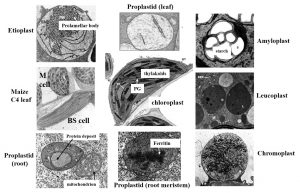Plants and algae are different from other organisms, such as humans and bacteria, in that they have an extra type of organelle in their cells, namely plastids. These plastids originate from photosynthetic cyanobacteria through endosymbiotic events that occurred some 1.5 billion years ago. Plastids produce many important primary and secondary metabolites, including various types of carbohydrates, amino acids, fatty acids, isoprenoids (e.g. carotenoids and vitamins E and K) and precursors to various plant hormones.
Chloroplasts are green plastids with internal thylakoid membranes that carry out photosynthesis, in addition to synthesis of many metabolites.
Other plastid types do not carry out photosynthesis and hence do not produce molecular oxygen. Such non-photosynthetic plastid types include red-orange colored chromoplastids enriched with carotenoids and xanthophylls (e.g. in red tomato and peppers), amyloplasts in starchy grains and roots (e.g. in wheat, maize kernels and potato), leucoplasts enriched with oils in e.g. trichomes (hairs on leaves) and etioplasts in white leaves of plants grown in the dark.
All plastids are derived from proplastids in meristematic cells – these proplastids have few internal structures, but can have iron deposits together with the protein ferritin, or protein deposits. Finally, C4 plants such as maize and sorghum have two types of leaf chloroplasts, each with specialized functions in dependence of cell type (bundle sheath (BS) and mesophyll (M) cells). A collection of microscopic images is shown below. The diameter of plastids are in the range of 1-7 micrometer, with chloroplasts typically being the largest.



